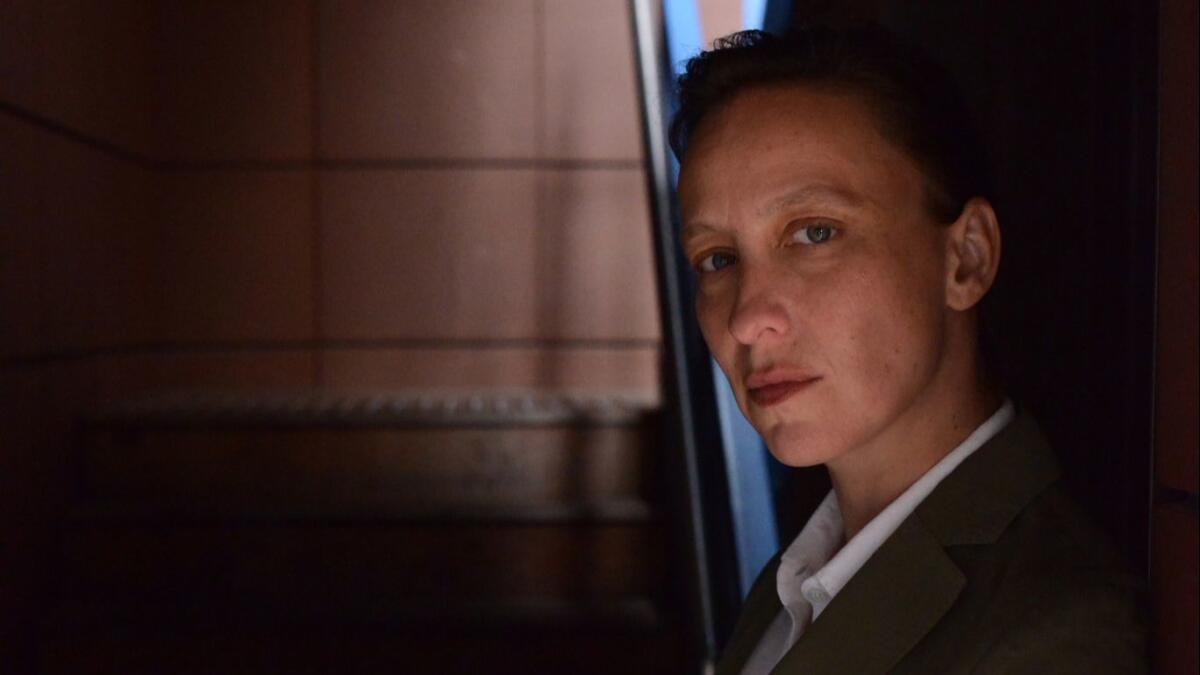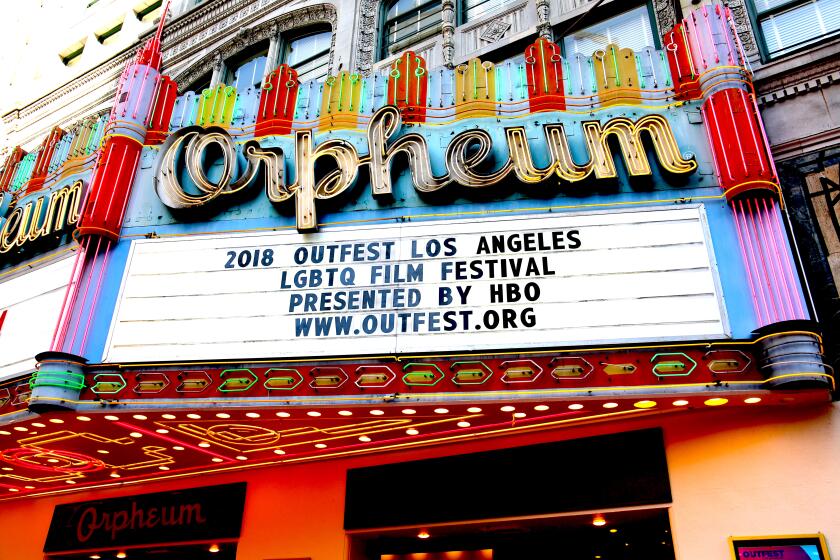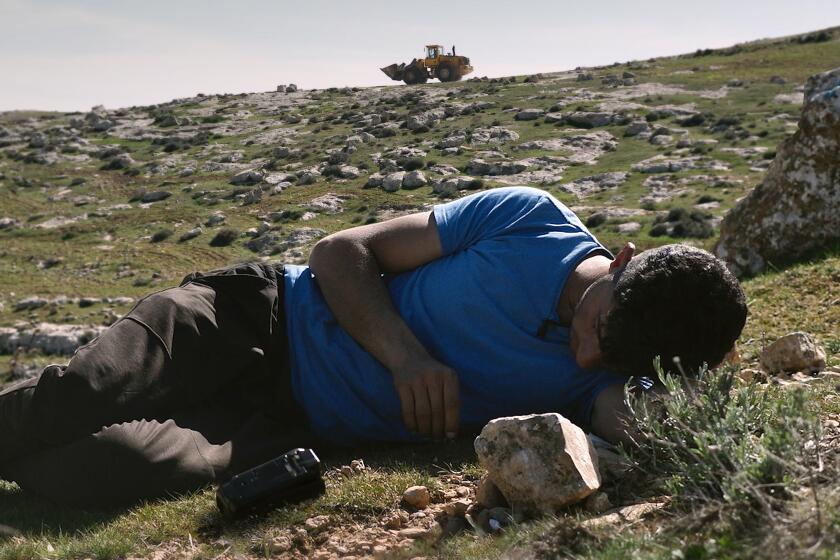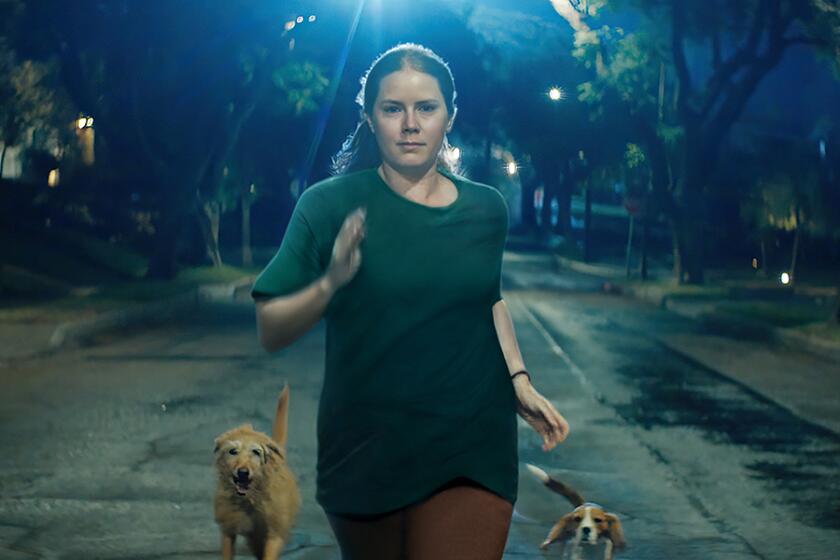Céline Sciamma takes the Cannes Film Festival by storm with ‘Portrait of a Lady on Fire’

- Share via
Reporting from Cannes, France — Céline Sciamma has been on the red carpet at Cannes before. Last year, she stood shoulder to shoulder with Agnès Varda, Cate Blanchett, Ava DuVernay, Kristen Stewart and other women as they marched up the steps of the Palais des Festivals to protest gender inequality in the film industry.
Eighty-two women marched in total, representing the number of female directors who had ever had movies selected for the main competition at Cannes (a paltry 4.2%, with 1,866 male-directed pictures making up the rest).
This year, that number went up to 86, and Sciamma is now one of them. She won the festival’s screenplay prize Saturday night for her glowingly received fourth feature, “Portrait of a Lady on Fire,” which follows an 18th century French painter named Marianne (Noémie Merlant), who falls in love with her latest subject, Héloïse (Adèle Haenel). It’s an exquisitely beautiful and contemplative chamber drama about the agonies of forbidden desire and the consolations of art, and particularly the mystery of how an artist’s gaze shapes — and is shaped in turn by — its subject.
Although the story is a fictional one, Marianne stands in for hundreds of female painters who were working in France at the time but whose contributions were never properly recognized. That makes “Portrait of a Lady on Fire” an especially pointed and resonant choice for the Cannes competition, where female filmmakers have long been underrepresented.
“I realize, as I speak, it’s so meta,” Sciamma says with a chuckle. “But it’s fun. It’s part of the joy of this whole thing.”
Joy seems to come easily to the 40-year-old French writer-director as we sit down to speak on a studio rooftop not far from the Palais. She is basking in the glow of an unusually strong reception, with more good news still to come. Within a few days, the film will leave the Croisette with not only a screenplay award from Alejandro Gonzalez Iñárritu’s jury but also the independently sponsored Queer Palm prize, given annually to an LGBTQ-themed film, and a North American distribution deal. Neon and Hulu are planning a theatrical release and awards campaign later this year.
“Portrait” is a movie of many firsts. It’s Sciamma’s first production starring established actors rather than gifted screen newcomers, and her first period drama. Still, she downplays the logistical challenges of re-creating an aristocratic 18th century household. (The picture was shot in Quiberon, on Brittany’s Côte Sauvage, or Wild Coast.)
When she talks about the movie — a love story layered with ideas about memory, equality and the lasting power of the image — a word she keeps using is “playful.”
“I really wanted to build the movie around rituals and variations, so that we could be playful with that,” she says. “I wanted to show how love and desire grow between two people, step by step … the rhythms, the breathing, the delays, the frustrations.
“It took me a while to find the right structure, even though it’s the ‘Titanic’ structure,” she notes with a laugh.
Indeed, “Portrait” begins with Marianne, a successful artist and teacher, being confronted with a long-buried memento and recalling her passionate brief encounter with Héloise several years ago. The story unfolds from there as an extended flashback set in 1770: We follow Marianne as she is commissioned by a countess (Valeria Golino) to paint a wedding portrait of her daughter, Héloïse, who is betrothed to a man from Italy. When Marianne arrives at their castle on the coast of Brittany, she is introduced as a new walking companion for Héloïse; for specific reasons, the painting must be done without the subject’s knowledge.
But that secret is one of many that are gradually brought into the open. When the countess leaves for a few days, Marianne and Héloïse are left alone, with only a sympathetic servant girl, Sophie (Luàna Bajrami), for company. The two are thus granted some time, however fleeting, to complete the painting, explore their desires and imagine a more liberated future.
In its explorations of gender and sexual identity, “Portrait of a Lady on Fire” grows naturally out of Sciamma’s previous work. The earlier films, however, were all coming-of-age narratives, starting with her 2007 Cannes-premiered debut feature, “Water Lilies,” which explored the adolescent frustrations among a team of synchronized swimmers.
The director’s assurance and ambition have grown with every feature, as borne out by “Tomboy” (2011), about a 10-year-old girl who passes herself off as a boy, and the particularly fine “Girlhood” (2014), about an African French teenager living on the outskirts of Paris. Sciamma has also cowritten several other strong French pictures, including Claude Barras’ “My Life as a Zucchini,” which earned an animated feature Oscar nomination, and André Téchiné’s “Being 17.”
With “Portrait of a Lady on Fire,” she wanted to stay true to the customs and manners of the past but also speak to audiences with a very modern directness. The costumes (designed by Dorothée Guiraud) are beautiful but functional, the elegant mise-en-scène more spare than sumptuous. The sharp, literate script avoids anachronisms, but it has also been stripped of excessive formalities. Marianne’s paintings, some of which are shown at various stages of completion, have a realism that feels ahead of their intended late 18th century moment. They are the work of painter Hélène Delmaire, who, at 32, is close to the same age as Marianne in the film.
The role of the flinty, resilient Héloïse was written specifically for Haenel, a rising star whose credits include “BPM (Beats Per Minute)” and “The Unknown Girl,” and who earned one of her first credits 12 years ago in “Water Lilies.” For the similarly tough-minded Marianne, the director cast the lesser-known Merlant, whom she thought would be the ideal counterbalance to Haenel.
“When Noémie came into the room, I felt there was this beautiful, iconic contrast between the blond [Haenel] and the brunet [Merlant],” Sciamma says. “But also they were the same age, they were the same height, and they were both very different. There was equality.”
“A love story with equality” is how Sciamma describes the end goal of “Portrait,” although here the notion of equality takes on many meanings. It’s apparent in the way the director (working with cinematographer Claire Mathon) often frames her actresses in two-shot, and also the surprising emotional weight she grants the character of Sophie. At a certain point, Héloïse stops being merely the object of Marianne’s gaze and becomes her collaborator, subverting the usual power dynamic in a way that also has implications for the relationship between a filmmaker and her actors.
Some early reviews have hailed the movie as an example of the “female gaze” at work, a corrective to the dominance of the “male gaze.” That term was coined decades earlier by film critic Laura Mulvey, but it retains critical currency today in an industry where most movies are made by men and, presumably, for men.
Sciamma, however, has a more complex reading of the two gazes and considers her perspective a hybrid of both. She also cautions against the assumption that every movie made by a female filmmaker automatically has “a feminine point of view.”
“I grew up in a world where stories and images were made and told by men. So I know this world very well. I am moved by this world,” says says. “I identify myself with the male gaze, I grew up with the male gaze, I’ve been excited by the male gaze. I’m a product of that culture.
“But I also have my experience as a woman, and so I know both worlds. So I guess with females, it should be acknowledged that we’re more hybrid. We can be anything. Maybe we’re more free to create.”
Sciamma’s filmmaking is of a piece with her activism. She is a founder of 50/50x2020, an organization that advocates for gender parity in the French film industry and that drafted a parity pledge that major festivals including Cannes, Berlin and Venice have all signed. As one of four female directors in competition at Cannes 2019 — a higher number than usual, though one that still reflects the industry’s underrepresentation of women — she considers herself fortunate to be part of “a beautiful conversation” about the importance of inclusion.
“It’s a lot of pressure,” she admits before adding, “There’s a responsibility, and I’m not complaining for myself, because I’m here, you know?”
More to Read
Only good movies
Get the Indie Focus newsletter, Mark Olsen's weekly guide to the world of cinema.
You may occasionally receive promotional content from the Los Angeles Times.











